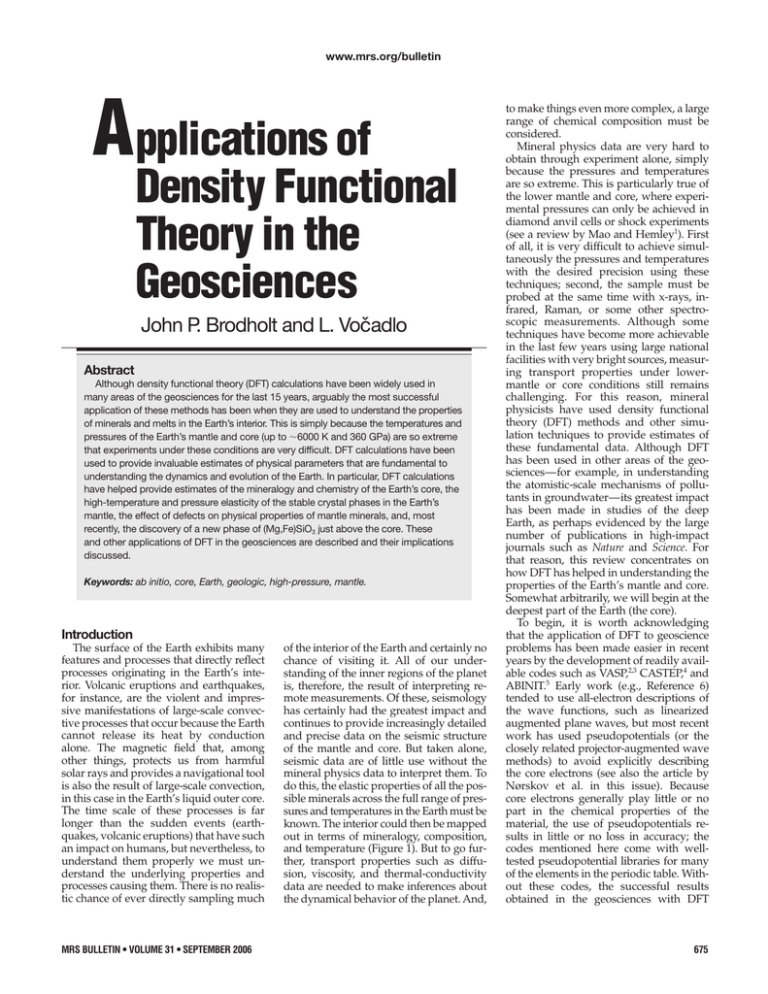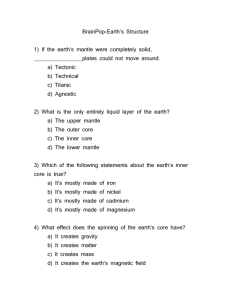Document 12881034
advertisement

www.mrs.org/bulletin Applications of Density Functional Theory in the Geosciences John P. Brodholt and L. Voc̀´adlo Abstract Although density functional theory (DFT) calculations have been widely used in many areas of the geosciences for the last 15 years, arguably the most successful application of these methods has been when they are used to understand the properties of minerals and melts in the Earth’s interior. This is simply because the temperatures and pressures of the Earth’s mantle and core (up to ⬃6000 K and 360 GPa) are so extreme that experiments under these conditions are very difficult. DFT calculations have been used to provide invaluable estimates of physical parameters that are fundamental to understanding the dynamics and evolution of the Earth. In particular, DFT calculations have helped provide estimates of the mineralogy and chemistry of the Earth’s core, the high-temperature and pressure elasticity of the stable crystal phases in the Earth’s mantle, the effect of defects on physical properties of mantle minerals, and, most recently, the discovery of a new phase of (Mg,Fe)SiO3 just above the core. These and other applications of DFT in the geosciences are described and their implications discussed. Keywords: ab initio, core, Earth, geologic, high-pressure, mantle. Introduction The surface of the Earth exhibits many features and processes that directly reflect processes originating in the Earth’s interior. Volcanic eruptions and earthquakes, for instance, are the violent and impressive manifestations of large-scale convective processes that occur because the Earth cannot release its heat by conduction alone. The magnetic field that, among other things, protects us from harmful solar rays and provides a navigational tool is also the result of large-scale convection, in this case in the Earth’s liquid outer core. The time scale of these processes is far longer than the sudden events (earthquakes, volcanic eruptions) that have such an impact on humans, but nevertheless, to understand them properly we must understand the underlying properties and processes causing them. There is no realistic chance of ever directly sampling much MRS BULLETIN • VOLUME 31 • SEPTEMBER 2006 of the interior of the Earth and certainly no chance of visiting it. All of our understanding of the inner regions of the planet is, therefore, the result of interpreting remote measurements. Of these, seismology has certainly had the greatest impact and continues to provide increasingly detailed and precise data on the seismic structure of the mantle and core. But taken alone, seismic data are of little use without the mineral physics data to interpret them. To do this, the elastic properties of all the possible minerals across the full range of pressures and temperatures in the Earth must be known. The interior could then be mapped out in terms of mineralogy, composition, and temperature (Figure 1). But to go further, transport properties such as diffusion, viscosity, and thermal-conductivity data are needed to make inferences about the dynamical behavior of the planet. And, to make things even more complex, a large range of chemical composition must be considered. Mineral physics data are very hard to obtain through experiment alone, simply because the pressures and temperatures are so extreme. This is particularly true of the lower mantle and core, where experimental pressures can only be achieved in diamond anvil cells or shock experiments (see a review by Mao and Hemley1). First of all, it is very difficult to achieve simultaneously the pressures and temperatures with the desired precision using these techniques; second, the sample must be probed at the same time with x-rays, infrared, Raman, or some other spectroscopic measurements. Although some techniques have become more achievable in the last few years using large national facilities with very bright sources, measuring transport properties under lowermantle or core conditions still remains challenging. For this reason, mineral physicists have used density functional theory (DFT) methods and other simulation techniques to provide estimates of these fundamental data. Although DFT has been used in other areas of the geosciences—for example, in understanding the atomistic-scale mechanisms of pollutants in groundwater—its greatest impact has been made in studies of the deep Earth, as perhaps evidenced by the large number of publications in high-impact journals such as Nature and Science. For that reason, this review concentrates on how DFT has helped in understanding the properties of the Earth’s mantle and core. Somewhat arbitrarily, we will begin at the deepest part of the Earth (the core). To begin, it is worth acknowledging that the application of DFT to geoscience problems has been made easier in recent years by the development of readily available codes such as VASP,2,3 CASTEP,4 and ABINIT.5 Early work (e.g., Reference 6) tended to use all-electron descriptions of the wave functions, such as linearized augmented plane waves, but most recent work has used pseudopotentials (or the closely related projector-augmented wave methods) to avoid explicitly describing the core electrons (see also the article by Nørskov et al. in this issue). Because core electrons generally play little or no part in the chemical properties of the material, the use of pseudopotentials results in little or no loss in accuracy; the codes mentioned here come with welltested pseudopotential libraries for many of the elements in the periodic table. Without these codes, the successful results obtained in the geosciences with DFT 675 Applications of Density Functional Theory in the Geosciences Figure 1. Schematic illustration of the interior of the Earth showing the major internal boundaries and layers and the major phases and compositions in these layers. Also shown are representative seismic waves that sample different parts of the planet. S represents the ray path of a shear wave from the source to a receiver, while SS is a shear wave with one bounce at the surface. A P wave is a compressional wave, with PKP sampling the outer core and PKIKP sampling both the outer and inner cores. D ⬙is a layer about 200 km thick at the bottom of the lower mantle just above the core. Pressures and depths are given at right. Temperatures are less well known, but mantle temperatures range from about 1400 K near the surface to ⬃3000 K near the core. Core temperatures are from ⬃4000 K to 6000 K. methods would have been much harder to come by. The Earth’s Core The core extends from ⬃2900 km below the Earth’s surface to its center at 6371 km. It has an outer molten part (the outer core) and an inner solid part with a radius of about 1220 km (the inner core). It has long been known to consist primarily of iron with ⬃5–10 wt% nickel and very small amounts (fractions of 1 wt% or less) of other siderophile elements such as chromium, manganese, phosphorus, and cobalt.7 However, the densities of both the outer and inner core are too low to consist of just an Fe-Ni alloy and must contain a few percent of light elements as well.8 Whereas small amounts of Ni are unlikely to drastically affect the properties of iron, the presence of light elements could have a significant effect, and the hunt for these light elements has been an active area of research for many years. The currently favored candidates are oxygen, sulfur, and silicon, although carbon and hydrogen have also been suggested. As will be discussed, the application of DFT is playing an important role in the search for the 676 light elements and their concentrations. However, the first fundamental question that must be addressed is, what is the crystal structure of Fe in the inner core? This is another area where DFT has been pivotal. Experimental and theoretical groups have put enormous effort into obtaining the phase diagram for pure Fe, but above relatively modest conditions there is much uncertainty in the results (see, e.g., Nguyen and Holmes9). At low temperatures and pressures the results are clear: under ambient conditions the ferromagnetic bcc phase of iron is stable, whereas at about 1200 K, it transforms to the paramagnetic fcc phase. At pressures of about 15 GPa but relatively low temperatures, the bcc phase transforms instead to the hcp phase. At simultaneously high pressures and temperatures, however, the results have been inconclusive, with several different groups, both experimental and theoretical, reporting a variety of phases. In the mid-1990s a number of studies presented first-principles calculations showing that the hcp phase is thermodynamically stable under core pressures, with elastic properties comparable to those observed in the core.10–12 This agreed nicely with high-pressure experimental results under ambient temperatures (e.g., Mao et al.13), and although some simultaneously high-pressure, high-temperature shock experiments suggested that another, as yet unknown, phase was stable,14 the bulk of the evidence seemed to point to pure Fe having the hcp structure at inner-core conditions. In particular, the early theoretical calculations ruled out the bcc phase for the inner core, even though a number of other transition metals are known to transform to the bcc structure just below their melting temperatures.15,16 Recently, however, new DFT calculations have started to challenge that view. High-temperature ab initio molecular dynamics (MD) simulations, which use DFT to calculate the forces required to move atoms around, have been performed on the hcp, fcc, and bcc phases of iron; these showed some surprising results.17 The bcc phase had been previously discounted since it was mechanically unstable at high pressure, but the new results showed that the mechanical instability disappeared at temperatures above ⬃3500 K, opening up the possibility that bcc could be the stable MRS BULLETIN • VOLUME 31 • SEPTEMBER 2006 Applications of Density Functional Theory in the Geosciences phase of Fe in the inner core. Although further calculations showed that the free energy of this bcc phase at core conditions is still higher than that of the hcp phase, it is only by a very small amount (⬃35 meV). This led the authors to conclude that although the hcp phase is the stable phase of pure Fe at core conditions, it is distinctly possible that the addition of light elements could stabilize the system in favor of the bcc phase. To illustrate this, take the example of Si as a candidate light element in the inner core. DFT calculations had previously predicted that the silicon alloy FeSi would crystallize in the CsCl structure at high pressures,18 a phase topologically equivalent to bcc; this CsCl-FeSi phase was subsequently observed in experiments.19 Furthermore, at low pressures and temperatures, experiments also showed that the presence of ⬃8 wt% Si stabilizes the bcc phase at conditions where pure Fe is in the hcp phase.20 Therefore, it is entirely conceivable that Si and other light elements could stabilize the bcc phase of iron over hcp in the inner core. However, to irrefutably resolve the issue of the crystal structure and composition of the inner core, free-energy calculations on all possible iron phases alloyed with light elements in the correct concentrations are needed—a highly complex study. Understanding the exact phase of iron in the inner core is not just of academic interest. The fine balance between the stability of various iron phases at inner-core conditions could be significant in the interpretation of recent seismic data which reveal that the inner core has a surprising amount of complexity.21–25 First, it is well established that the inner core exhibits significant anisotropy, with average compressional velocities that are ⬃3% faster along the polar axis than in the equatorial plane.21,22 Early models for the inner core suggest that the seismic anisotropy has cylindrical symmetry, with the symmetry axis parallel to the Earth’s rotation axis. Secondly, it seems to be layered. The observations suggest a seismically isotropic upper layer (or shell) that has a variable thickness of ⬃100–400 km. This outer layer overlays an irregular, nonspherical, transition region to an anisotropic lower layer.23,24 The existence of the isotropic upper layer implies that the magnitude of the seismic anisotropy in the lower inner core should be significantly greater than previously thought, possibly as much as 5–10%.24 The origin of the anisotropy and layering is fundamental to understanding and constraining evolutionary models for the Earth’s inner core, and there have been a number of suggestions to account for it. 26,27 MRS BULLETIN • VOLUME 31 • SEPTEMBER 2006 The isotropic upper layer could arise from either randomly oriented crystals or a material with a low intrinsic anisotropy, while the anisotropic lower layer is most likely to be due to the preferred orientation of aligned crystals, although there are other alternatives such as pockets of melt. Why this layering exists is not clear, but it may simply be that the inner layer has a different crystalline phase of iron than the outer layer, and that the phase in the inner layer has a higher intrinsic anisotropy than the outer layer or has slip systems that more easily produce lattice-preferred orientation. Clearly, the inner core is more complex than previously thought, and in order to interpret these seismological observations it is essential to know the physical properties of the phases present; a solution must be found that matches the observed anisotropy and layering. Seismic observations suggest that lightelement concentrations in the outer core are greater than those in the inner core, presumably because of preferential partitioning into the melt. In 2001, DFT calculations were performed to obtain the chemical potentials of candidate light elements S, Si, and O and provide a much-needed constraint on core composition.28 Under the assumption of chemical equilibrium at the inner-core boundary, these calculations showed that S and Si partition equally into the outer and inner core, whereas O partitions much more strongly into the outer core. To satisfy the constraints provided by seismological observations, this work proposes a compositional model whereby the outer core consists of ⬃10 mol% S and/or Si with ⬃8 mol% O and an inner core of ⬃8.5 mol% S and/or Si with only ⬃0.2 mol% O. The release of latent heat of crystallization, together with chemical buoyancy arising from the enrichment of the outer core with light elements, provides much of the driving force of the geodynamo and, hence, the Earth’s magnetic field. However, in the past, an understanding of outer-core convection was hampered by uncertainties in viscosity estimates that spanned some 12 orders of magnitude.29 In a series of papers using DFT and finitetemperature MD, this issue was essentially resolved.30–32 In the first of these papers,30 a calculation on pure Fe at core conditions showed that it had a viscosity on the order of 10 mPa s, at the low end of previous estimates.30 This almost negligible viscosity suggested that the outer core is an inviscid fluid undergoing small-scale circulation and turbulent convection. Using the same methodology, calculations were then performed on FeS at core conditions,31 which showed that the presence of S had little impact on the result. Finally, in order to validate the methodology, calculations were performed on FeS at experimentally accessible conditions;32 it was found that both theory and experiment were in excellent agreement, both supporting a high-diffusivity, low-viscosity liquid. The combined results from all three studies suggest that there is no significant variation in viscosity, diffusivity, or liquid structure as a function of pressure, temperature, and/or composition, suggesting that whatever the light element in the outer core, the viscosity will remain at a few mPa s (i.e., about the same viscosity as water). The Earth’s Mantle The Earth’s mantle extends from below the crust down to the core, and like the core, it is subdivided into different layers that show up as sharp discontinuities in seismic profiles. The main discontinuities are at ⬃410 km and ⬃670 km, with another weaker one at ⬃520 km. These are generally believed to be the result of solid–solid phase transitions. The lower mantle (below 670 km) is the largest part of the Earth, occupying ⬃55% of it by volume. It is believed to consist predominantly of magnesium-rich silicate perovskite, (Mg,Fe)SiO3, with a smaller amount (⬃20%) of an oxide, (Mg,Fe)O, and even smaller amounts of minor phases such as a calcium–silicate perovskite. Also like the core, the pressures and temperatures are too high for most experimental techniques, and results from DFT have been particularly invaluable in understanding this part of the planet. For example, in 1993 three papers by different authors used DFT and Hartree–Fock methods to predict that the orthorhombic Pbnm phase of MgSiO3 would be stable over the cubic and tetragonal phases throughout the pressure and temperature range of the mantle.33–35 Despite the occasional result suggesting otherwise, the bulk of experimental and theoretical work that followed has supported this prediction, and the result is still valid today. Two years after this early success, DFT calculations were used to predict the elastic constants of MgSiO3 perovskite at high pressures.36 These data were absolutely essential for comparison to the seismic observations in the lower mantle and at that time were impossible to achieve experimentally. A number of other workers continued this early work using different approximations, and Oganov et al.37,38 produced a set of DFT-based elastic constants, of which eight of the nine agreed with experimental results to within 4% and the ninth to within 10%. Although these data were very useful, the calculations were 677 Applications of Density Functional Theory in the Geosciences done at 0 K, and extrapolating these results to temperatures in excess of 2500 K is not without risk. This motivated Oganov et al.37,38 to use ab initio MD in predicting the simultaneous high-temperature and high-pressure elastic constants of MgSiO3 perovskite, numbers that are still not obtainable from experiment. These and similar results39 enabled seismologists to gain quantitative insights into fundamental aspects of the interior, such as the horizontal variation in temperature (which drives convection), and to estimate whether the Earth’s mantle is chemically homogeneous or whether there are significant variations in chemistry. These questions have profound implications for understanding how the Earth was formed and how it has evolved. A recent example of this is by Trampert et al.,40 who used ab initio elasticity results in conjunction with seismology in suggesting that the mantle must have variations in Fe content of up to ⬃4%. Although these may seem small, in fact they are sufficiently large to be more important than temperature in driving convection in the deepest part of the mantle. Whether these conclusions stand the test of time remains to be seen, but they emphasize the importance of ab initio simulations to the Earth sciences. Although relatively rare, DFT methods have been used quite successfully in understanding how crystal defects (both intrinsic and extrinsic) can affect the properties of mantle minerals and therefore the mantle itself. For instance, Brodholt 41 calculated the energetics of different point defects in olivines (the major uppermantle mineral) and noted that cation vacancies would be concentrated on only half of the possible cation sites (the M1 sites). He then used this information to understand how the observed anisotropy in diffusion rates relative to different crystallographic directions is related to the fact that cations could only hop between M1 sites. A later transmission electron microscopy study confirmed that magnesium vacancies were indeed restricted to the M1 sites.42 DFT methods are also being used to understand the role of hydroxyl defects in Earth-forming minerals that nominally contain no water. This has been an active area of interest since it was observed that mantle minerals often contain a much greater concentration of water than previously thought.43 This was an important observation because water may weaken minerals considerably (hydrolytic weakening); this then has implications for the rheology of mantle rocks and consequently the style of convection in the 678 mantle. Understanding how and where hydrolytic weakening occurs in rocks has, therefore, become a matter of some importance. McConnell et al.44 used DFT energies to study the solubility of water in quartz and showed that water was incorporated into quartz in the form of hydrogarnet substitution (i.e., four protons for a silicon ion). They then hypothesized that the dehydration of these hydroxyl defects nucleated prismatic dislocation loops, which in turn led to a significantly weakened material. A different mechanism for hydrolytic weakening of olivine was put forward by Brodholt and Refson45 on the basis of their DFT calculations. They suggested that the role of water was to greatly increase the concentration of silicon vacancies relative to the concentration in dry olivine and thereby greatly increase the mobility of silicon ions. Because silicon is the slowest-diffusing species in dry olivine, it should be rate-limiting in any diffusion-controlled creep; increasing the mobility of silicon would therefore provide a mechanism for hydrolytically weakening olivine. Another example where DFT calculations on defects has played a considerable part is in the mechanism for incorporating A13+ into MgSiO3 perovskite. This work was motivated by an experimental observation showing that relatively small concentrations of A13+ in perovskite (on the order of 5%) had an inordinately large effect on the compressibility of the perovskite.46 This was not just of academic interest, because this amount of alumina is about that expected in mantle perovskites, and if confirmed, it would have important consequences for the composition of the mantle itself. It was also postulated that A13+ could have such a large effect on the elasticity of perovskite if it substituted for silicon and was charge-balanced by oxygen vacancies (as opposed to substituting for both silicon and magnesium, which requires no vacancies for charge balance). If true, this would add another interesting twist to our understanding of the lower mantle because such a large concentration of oxygen vacancies would most likely strongly change its transport properties. Interestingly, the DFT calculations did in fact confirm that the enhanced elasticity could only be explained by the mechanism that required oxygen vacancies for charge balance,47,48 but they also showed that it was not actually the thermodynamically favored mechanism. In other words, the oxygen vacancy mechanism explains the compressional data, but it should not thermodynamically exist. Since then a number of experimental studies have tried to reproduce the experimental results of Zhang and Weidner 46 but failed,49 so it would seem that the mantle does not have a huge concentration of oxygen vacancies after all—a somewhat less exciting result, but nevertheless one that DFT calculations played a big part in achieving. The Dⴖ Layer The most recent example of where DFT calculations have provided the crucial link between observation and experiment is with the discovery of a new mantle phase that is just stable at the very bottom of the mantle. The discovery of this new phase (imaginatively nicknamed “postperovskite”) has met with some excitement because it seems to be able to explain some intriguing observations at the bottom of the mantle that until last year defied a simple explanation. The lowermost 200 km or so of the mantle is called D⬙. The name D⬙ is a leftover from the famous geophysicist Harold Bullen, who in the 1940s gave each of the seismically defined layers of the Earth a letter designation. The letter D was originally given to all of the lower mantle, but it later became clear that the mantle should be divided into two; pragmatically, Bullen simply named them D⬘ and D⬙. Almost all the other layers have since been given a proper name (i.e., crust, upper mantle, inner core, etc.), but D⬙ survived, although it was recently suggested that it be renamed the “Bullen layer.”50 D⬙ is unusual in that it is the boundary between a hot liquid metal core and the hot solid rocky mantle, and as such we may well expect a rich geology there. The region is characterized by seismic properties quite unlike the rest of the mantle.51 For instance, it is seismically very variable and anisotropic. Some areas have a strong seismic reflector, whereas other areas seem to have none. In some areas a double reflector has been observed. At various times, D⬙ has been attributed to a reaction zone between the core and the mantle, a “graveyard” for subducting slabs, and a phase transition.52,53 This last one, a phase transition, was perhaps the least appealing, because no phase transition had been observed experimentally. However, this all changed with the discovery that the orthorhombic perovskite phase did indeed transform to another phase under near-D⬙ conditions. The first published account was by Murakami et al.54 in which they reported the breakdown of the orthorhombic Pbnm MgSiO3 perovskite to a phase isostructural with CaIrO3 (space group Cmcm) (Figure 2). On the face of it this phase is layered, and the authors proposed that it could account for the seismic anisotropy, MRS BULLETIN • VOLUME 31 • SEPTEMBER 2006 Applications of Density Functional Theory in the Geosciences future. In particular, we believe that the next challenge for the deep Earth will be to place quantitative estimates on transport properties. Activation energies for diffusion will be perhaps the easiest, but providing estimates for activation energies in dislocation creep, grain-boundary sliding, or thermal conductivity (both phonon and radiative) will be more challenging. Nevertheless, the challenges for experimentation are perhaps greater, and so DFT or post-DFT ab initio calculations will continue to provide essential estimates of fundamental data as well as aid in interpreting and testing experimental results. References Figure 2. Structure of (a) the orthorhombic MgSiO3 perovskite compared with (b) the recently discovered “post-perovskite” phase. The post-perovskite phase is able to explain many of the enigmatic features of the D ⬙layer of the Earth’s mantle that have defied satisfactory explanation since the 1940s. The post-perovskite phase is isostructural with CaIrO3 and has the Cmcm space group. The approximate dimensions (depending on the pressure and temperature conditions) of the unit cell of perovskite are a 苷 4.5 Å, b 苷 4.6 Å, and c 苷 6.5 Å. In post-perovskite, the unit cell dimensions are about a 苷 2.5 Å, b 苷 8.1 Å, and c 苷 6.1 Å. but they had no data with which to test this. No sooner had the ink dried than papers were published using DFT calculations to confirm that the new phase was indeed stable over the perovskite phase.55,56 Moreover, these and other papers using DFT methods provided the much-needed data to test whether this phase could account for the observed properties of D⬙. For instance, Tsuchiya et al.56 used quasi-harmonic calculations to show that the Clapyron slope of the perovskite to post-perovskite phase change was consistent with the observed topography of D⬙, and Oganov and Ono,55 Iitaka et al.,57 and Tsuchiya et al.58 predicted the athermal elastic constants and showed that the post-perovskite phase was indeed seismically very anisotropic. A flurry of further DFT papers during the next year filled in more of the picture, including the high-temperature elastic constants as obtained by ab initio MD,59,60 and the effect of aluminum, iron, and calcium on the phase boundary and elasticity.61–64 Although the new phase does not (yet?) explain everything about the D⬙ layer, it certainly goes further than any other hypothesis. From the point of view of this review, it also serves to show how useful DFT calculations are in the geosciences and how ingrained in the subject they now are. MRS BULLETIN • VOLUME 31 • SEPTEMBER 2006 Conclusions Although we have concentrated here on applications of density functional theory to the deep Earth (core and mantle), there are many other areas of the geosciences where ab initio calculations have an important role. For instance, the combination of spectroscopic techniques with DFT makes a particularly powerful tool for understanding the coordination environment of ions in aqueous solutions.65 Similarly, combining DFT calculations with techniques such as extended x-ray absorption fine structure is a powerful way to probe the mechanism of absorption of ions and molecules onto surfaces (e.g., References 66 and 67). Both of these have a direct environmental benefit. The illite–smectite clay minerals have also been studied with DFT with a view to understanding the diagenetic process (the process of turning sediment into rock),68 something that has implications for the maturation, migration, and development of hydrocarbons; and ab initio MD simulations have recently been applied to silicate melts. But we would argue that nowhere has the application been so successful as in predicting the properties of minerals under the high temperatures and pressures of the Earth’s mantle and core. There are many important areas where DFT will continue to play a role in the 1. H.K. Mao and R.J. Hemley, Rev. Mineral. 37 (1998) p. 1. 2. G. Kresse and J. Furthmuller, Phys. Rev. B 54 (1996) p. 11169. 3. G. Kresse and J. Furthmuller, Comput. Mater. Sci. 6 (1996) p. 15. 4. M.D. Segall, P.J.D. Lindan, M.J. Probert, C.J. Pickard, P.J. Hasnip, S.J. Clark, and M.C. Payne, J. Phys.: Condens. Matter 14 (2002) p. 2717. 5. X. Gonze, G.M. Rignanese, M. Verstraete, J.M. Beuken, Y. Pouillon, R. Caracas, F. Jollet, M. Torrent, G. Zerah, M. Mikami, P. Ghosez, M. Veithen, J.Y. Raty, V. Olevanov, F. Bruneval, L. Reining, R. Godby, G. Onida, D.R. Hamann, and D.C. Allan, Z. Kristallogr. 220 (2005) p. 558. 6. L. Stixrude and R.E. Cohen, Geophys. Res. Lett. 22 (1995) p. 125. 7. J.D.C. McDonough and S.S. Sun, Chem. Geol. 120 (1995) p. 233. 8. F. Birch, J. Geophys. Res. 69 (1964) p. 4377. 9. J.H. Nguyen and N.C. Holmes, Nature 27 (2004) p. 427. 10. L. Voc̀´adlo, J.P. Brodholt, D. Alfe, M. Gillan, and G.P. Price, Phys. Earth Planet. Int. 26 (2000) p. 123. 11. P. Soderlind, J.A. Moriarty, and J.M. Wills, Phys. Rev. B 53 (1996) p. 14063. 12. L. Voc̀´adlo, J. Brodholt, D. Alfe, M.J. Gillan, and G.D. Price, Phys. Earth Planet. Int. 117 (2000) p. 123. 13. H.K. Mao, J. Xu, V.V. Struzhkin, J. Shu, R.J. Hemley, W. Sturhahn, M.Y. Hu, E.E. Alp, L. Voc̀´adlo, D. Alfe, G.D. Price, M.J. Gillan, M. Schwoerer-Bohning, D. Hausermann, P. Eng, G. Shen, H. Giefers, R. Lubbers, and G. Wortmann, Science 292 (2001) p. 914. 14. M.J. Brown, Geophys. Res. Lett. 28 (2001) p. 4339. 15. W. Petry, J. Phys. IV 5 (1995) p. 15. 16. J. Trampenau, A. Heiming, W. Petry, M. Alba, C. Herzig, W. Miekeley, and H.R. Schober, Phys. Rev. B 43 (1991) p. 10963. 17. L. Voc̀´adlo, D. Alfe, M.J. Gillan, I.G. Wood, J.P. Brodholt, and G.D. Price, Nature 424 (2003) p. 536. 18. L. Voc̀´adlo, G.D. Price, and I.G. Wood, Acta Crystallogr., Sect B: Struct. Sci. 55 (1999) p. 484. 19. D.P. Dobson, L. Voc̀´adlo, and I.G. Wood, Am. Mineral. 87 (2002) p. 784. 20. J.F. Lin, D.L. Heinz, A.J. Campbell, J.M. Devine, and G.Y. Shen, Science 295 (2002) p. 313. 21. K.C. Creager, Nature 356 (1992) p. 309. 679 Applications of Density Functional Theory in the Geosciences 22. X.D. Song and D.V. Helmberger, Geophys. Res. Lett. 20 (1993) p. 2591. 23. X.D. Song and D.V. Helmberger, Science 282 (1998) p. 924. 24. X.D. Song and X.X. Xu, Geophys. Res. Lett. 29 (2002). 25. C. Beghein and J. Trampert, Science 299 (2003) p. 552. 26. S. Yoshida, I. Sumita, and M. Kumazawa, J. Geophys. Res.: Solid Earth 101 (1996) p. 28085. 27. B.A. Buffett and H.R. Wenk, Nature 413 (2001) p. 60. 28. D. Alfe, M.J. Gillan, and G.D. Price, Nature 405 (2000) p. 172. 29. J.-P. Poirier, Geophys. J. 92 (1988) p. 99. 30. G.A. de Wijs, G. Kresse, L. Voc̀´adlo, D. Dobson, D. Alfe, M.J. Gillan, and G.D. Price, Nature 392 (1998) p. 805. 31. D. Alfe and M.J. Gillan, Phys. Rev. B 58 (1998) p. 8248. 32. L. Voc̀´adlo, D. Alfe, G.D. Price, and M.J. Gillan, Phys. Earth Planet. Int. 120 (2000) p. 145. 33. R.M. Wentzcovitch, J.L. Martins, and G.D. Price, Phys. Rev. Lett. 70 (1993) p. 3947. 34. L. Stixrude and R.E. Cohen, Nature 364 (1993) p. 613. 35. P. D’Arco, G. Sandrone, R. Dovesi, R. Orlando, and V.R. Saunders, Phys. Chem. Miner. 20 (1993) p. 407. 36. R. Wentzcovitch, N.L. Ross, and G.D. Price, Phys. Earth Planet. Int. 90 (1995) p. 101. 37. A.R. Oganov, J.P. Brodholt, and G.D. Price, Earth Planet. Sci. Lett. 184 (2001) p. 555. 38. A.R. Oganov, J.P. Brodholt, and G.D. Price, Nature 411 (2001) p. 934. 39. R.M. Wentzcovitch, B.B. Karki, M. Cococcioni, and S. de Gironcoli, Phys. Rev. Lett. 92 (2004). 40. J. Trampert, F. Deschamps, J. Resovsky, and D. Yuen, Science 306 (2004) p. 853. 41. J.P. Brodholt, Am. Mineral. 82 (1997) p. 1049. 42. D.E. Janney and J.F. Banfield, Am. Mineral. 83 (1998) p. 799. 43. D.R. Bell and G.R. Rossman, Science 255 (1992) p. 1391. 44. J.D.C. McConnell, J.S. Lin, and V. Heine, Phys. Chem. Mineral. 22 (1995) p. 357. 45. J.P. Brodholt and K. Refson, J. Geophys. Res. 105 (2000) p. 18977. 46. J. Zhang and D.J. Weidner, Science 284 (1999) p. 782. 47. T. Yamamoto, D.A. Yuen, and T. Ebisuzaki, Earth Planet. Sci. Lett. 206 (2003) p. 617. 48. J.P. Brodholt, Nature 207 (2000) p. 620. 49. M.J. Walter, A. Kubo, T. Yoshino, J. Brodholt, K.T. Koga, and Y. Ohishi, Earth Planet. Sci. Lett. 222 (2004) p. 501. 50. B. Chao, Eos: Trans. Amer. Geophys. Union 81 (2000) p. 46. 51. M.E. Wysession, T. Lay, J. Revenaugh, Q. Williams, E.J. Garnero, R. Jeanloz, and L.H. Kellogg, in The Core–Mantle Boundary Region, Vol. 28, edited by M. Gurnis, M.E. Wysession, E. Knittle, and B.A. Buffett (American Geophysical Union, Washington, DC, 1998) p. 273. 52. I. Sidorin, M. Gurnis, and D.V. Helmberger, Science 286 (1999) p. 1326. 53. I. Sidorin, M. Gurnis, and D.V. Helmberger, J. Geophys. Res.: Solid Earth 104 (1999) p. 15005. ■ Trace and Ultra Trace Elemental Analysis Laboratory ■ Bulk, Near Surface and Depth Profile Elemental Evaluation ■ Conductive, Non Conductive and Semi Conductive Materials Analysis from H to U (solids and powders) ■ Minimum sample requirements (less than one gram required for 75 elements scan) ■ Analytical Capabilities • Trace Elemental Analysis by GD/MS • Compositional Analysis by ICP-OES • Metallography • C and S by Combustion Technique • N,O, H by Inert Gas Fusion 54. M. Murakami, K. Hirose, K. Kawamura, N. Sata, and Y. Ohishi, Science 304 (2004) p. 855. 55. A. Oganov and S. Ono, Nature 430 (2004) p. 445. 56. T. Tsuchiya, J. Tsuchiya, K. Umemoto, and R.M. Wentzcovitch, Earth Planet. Sci. Lett. 224 (2004) p. 241. 57. T. Iitaka, K. Hirose, K. Kawamura, and M. Murakami, Nature 430 (2004) p. 442. 58. T. Tsuchiya, J. Tsuchiya, K. Umemoto, and R.M. Wentzcovitch, Geophys. Res. Lett. 31 L14603 (2004). 59. J. Wookey, S. Stackhouse, J.M. Kendall, J. Brodholt, and G.D. Price, Nature 438 (2005) p. 1004. 60. S. Stackhouse, J.P. Brodholt, and G.D. Price, Geophys. Res. Lett. 32 (2005) article No. L13305. 61. S. Stackhouse, J.P. Brodholt, and G.D. Price, Geophys. Res. Lett. 33 (2006) article No. L01304. 62. S. Akber-Knutson, G. Steinle-Neumann, and P.D. Asimow, Geophys. Res. Lett. 32 (2005) article No. L14303. 63. R. Caracas and R.E. Cohen, Geophys. Res. Lett. 32 (2005) article No. L16310. 64. D.Y. Jung and A.R. Oganov, Phys. Chem. Miner. 32 (2005) p. 146. 65. D.J. Harris, J.P. Brodholt, and D.M. Sherman, J. Phys. Chem. B 107 (2003) p. 9056. 66. D.M. Sherman, Geochim. Cosmochim. Acta 69 (2005) p. 3249. 67. C.L. Peacock and D.M. Sherman, Geochim. Cosmochim. Acta 68 (2004) p. 2623. 68. L. Stixrude and D.R. Peacor, Nature 420 (2002) p. 165. ⵧ Shiva Technologies Inc. 6707 Brooklawn Parkway Syracuse, NY 13211 Phone: 315-431-9900 Fax: 315-431-9800 sales@shivatec.com ISO 9002, NADCAP, GE—S400 Lab facilities in US, Europe and Asia www.shivatec.com For more information, see http://www.mrs.org/bulletin_ads 680 www.mrs.org/bulletin MRS BULLETIN • VOLUME 31 • SEPTEMBER 2006







